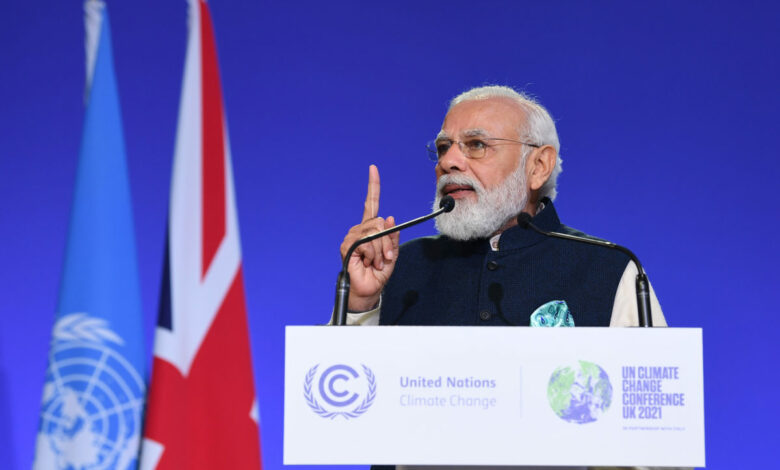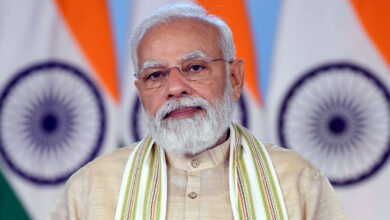Will India meet its targets in terms of climate change till 2070?

During the Glasgow climate summit, India’s Prime Minister Narendra Modi set the goal that his country will be net carbon neutral by 2070, far later than most other countries in attendance.
India must also reduce a billion tonnes of emissions by 2030.
Indians are the third-largest emitters of carbon dioxide (CO2) after China and the US.
If action is not taken to curb its emissions, its emissions will rise steeply due to both its rapidly growing population and its heavy coal and oil-dependent economy.
India has promised to reduce its emissions.
As far as India is concerned, there should be no overall reduction target because industrialised countries have contributed far more to global warming.
According to the report, comparing emissions per unit of GDP or emissions intensity is fairer to compare China to other countries.
India’s emissions intensity is expected to be lowered by 45% (that is, of all greenhouse gases, not just CO2) by 2030, which is a much more aggressive goal than its previous goal of a 33-35% cut from 2005 levels by 2030.
However, a drop in carbon emissions intensity does not always translate into a decline in global emissions.
Likely, the target will not impact reducing overall projected emissions, according to Climate Action Tracker (CAT).
IPCC says a target of global net-zero, whereby a country does not contribute to greenhouse gas emissions in the atmosphere, by 2050 is the minimum required to keep average global temperatures from rising by 1.5C.
The goal has been publicly committed to by more than 140 countries.
Earlier this year, India’s prime minister announced its intention to increase energy capacity using non-fossil fuels to 500 gigawatts (GW) by 2030.
It has a current capacity of around 100 GW and aims to reach 175 GW by next year, but it is likely to miss that target.
Climate Action Tracker says the 2030 target, while more ambitious, will have a negligible impact on real-world emissions.
As well, India announced in 2015 that it will supply 40% of its power from non-fossil sources by 2030. The figure has now been raised to 50% by Mr Modi.
According to India’s official statistics, the generation capacity from these sources stood at approximately 39% in September this year.
The International Energy Agency (IEA) reports a 20 per cent decrease in electricity generation in 2020.
By the Paris Agreement, Cindy Baxter of CAT says developing countries such as India need assistance from international sources to decarbonise their economies and curb temperature increases.
It does not have a conditional target which identifies what kind of help it needs or where.”
As part of COP26, India abstained from signing a global agreement to reduce methane gas emissions.
Agriculture, fossil fuels, and waste are among the significant sources of this greenhouse gas in India.
Does India’s forest cover expand?

Forests are capable of absorbing carbon dioxide, a reason why India has set a goal of covering a third of its land area with trees.
Although it hasn’t provided a timescale, there has been uneven progress.
Although India’s southern parts have seen reforestation initiatives, the north-eastern region’s forest cover has diminished.
It is also planned that the country will plant enough trees to absorb an additional 2.5-3 billion tonnes of CO2 by 2030.
During the period 2001 to 2020, India lost 18% of its primary forests and 5% of its tree cover, according to Global Forest Watch, a collaboration between the University of Maryland, Google, the US Geological Survey, and NASA.
Yet, according to government data, forest cover increased by 5.2% from 2001 to 2019.
India’s official figures are based on tree density in an area, whereas GFW includes only vegetation taller than 5 m (16 ft).
Environment and socialism in India

The 15th of August, 1947, was the day India gained independence from Britain. From the early 1980s to the early 1990s, India’s leading economic and social policies were shaped by socialism.
In economics and politics, socialists believe that the public should own all means of production. Under a socialist system, the government is responsible for making all legal decisions related to production and distribution, and the government determines prices and output. Before the early 1990s, India did not have a free market.
An economy with a free market is one where competition is rampant, and buyers and sellers carry out their transactions privately. Throughout the first 45 years of our independence, numerous economic collapses occurred without the free market.
Many Indians were disappointed by the economic stagnation, chronic shortages, and state inefficiency that led to the fall of socialism and hatred of it. In the early 1990s, the economy shifted to free-market principles.
Despite 27 years of capitalism and free markets, environmentalist protests in almost every state where the government wants to start developing land are hurting our nation’s growth.
My attendance at a high-level government meeting about clearing around 20 acres of land backfired when environmentalists filed a PIL, forcing the project to be postponed again. They compared India to the West, and I was shocked.
The preservation of the environment cannot be more important than economic growth, and India cannot be compared to North America’s and European nations’ sustainability models. There were centuries of capitalist governments in the United States that focused on ambitious development 240 years ago.
Due to this, Americans could combat job deficiency, and their GDP per capita increased from 63,416 dollars to 63,417 dollars. They are now focusing on sustainability, which is an intelligent decision. Two hundred forty years of head start wasn’t enough! We have less than 2000 dollars in GDP per person.
Our goal should be to develop, and it is imperative to increase employment opportunities. A better, more comfortable life is not Adani’s enemy but our hope for a better life. It is dangerous to hate our capitalist heroes.
Overpopulation is the problem in certain cities, and lack of jobs is the problem. Developing infrastructure could provide jobs if we have enough land. If both sides cooperate rather than protest, environmental protection can coexist with private infra development.
Our nation accounts for 2.4% of the world’s surface but has forest cover covering 24.4% of the land area. India’s pollution is mainly caused by vehicles and crop burning (27 %). Transit can reduce vehicle movement, and crop burning does not result from infrastructure development but agricultural errors.
For those genuinely interested in the environment, this piece is not for you. Thank you all, and keep up the excellent work. In contrast, I want to point out those pseudo-environmentalists with wealthy parents who evade taxes. Let’s not slow development down. Let’s not compare ourselves to European nations.
European nations achieved freedom and free-market capitalism centuries before us. The Indian youth will flood the three to four Indian cities with growth and improvement if there are no developments in small towns and small states.
Infrastructure development is not the problem. Overpopulation and congestion are the problems. Congestion is a result of environmental laws. Without space for expansion, we cannot expand. Unless both sides sit down and talk it out, environment preservation and development cannot coexist.
The people of our nation do not deserve poverty, so stop protesting. We should provide them with opportunities to work, earn, and grow in modern industries. Bringing in companies is the only way to do that.
The Sustainable Development Agenda must be a fundamental cornerstone of eradicating poverty to ensure future economic and business growth. Employment should not be threatened, nor should development be halted.
Fighting climate change with eco-socialism

The melting glaciers in Peru remain a memorable image. TV channels had sent reporters to cover the most drastic climate change impacts on Lima, host of the 20th Conference of Parties (COP20) on climate change. In the Peruvian Andes, glacial ice melting has received much attention.
There was a starkness to the pictures. A volcanic plain about 5,500 metres above sea level, Quelccaya, has seen its ice cap recede dramatically, revealing a landscape filled with jagged swathes of dark rock.
Between 1939 and 2009, the Andes experienced a 0.7° C rise in temperature, which caused the glacial ice that had formed around 1,800 years ago to retreat by more than 20 per cent.
In addition, reports indicate that President Ollanta Humala’s government has implemented regressive policies on environmental protection. Environmental safeguards are rapidly being dismantled under India’s new BJP regime, led by Narendra Modi.
Violence has erupted between indigenous people in Peru and oil companies resisting land grabs, and several people have been killed. The rate at which India gives its land away for industrial development and industry is alarming.
The Modi Cabinet has given away 1,35,000 hectares of land for various projects in the last three months alone, a minister in the Lima government revealed. Maneka Gandhi, minister for women and child development, said during a symposium on the importance of forest foods to Adivasis that forest issues are never discussed in the Cabinet. Gandhi also said she feared letting forests be would be difficult.
It is the same in Lima as in Delhi: environmental laws must be shortened to attract investments. Due to this backdrop, it isn’t easy to understand why COP20 was unable to secure binding emission targets so that each nation can decide what it wants to do to reduce emissions if any.
How can we save the planet? The country’s extraordinary President Evo Morales believes that eco-socialism is the only way to fight the climate crisis as an alternative to the current economic system.
A Joint Mitigation Adaptation (JMA) approach is proposed for “integrating the holistic views of indigenous peoples, locally-based communities and locally-based resource users about the environment.” This project promises greater gender equality and women’s empowerment.
The vast majority of governments and economists are likely to dismiss this as socialist twaddle or utopia. Conventional thinking tends to be changed by terms such as eco-socialism, Mother Earth, and indigenous people.
edited and proofread by : nikita sharma






